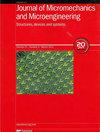静电纺制聚乳酸多孔纳米纤维的实验研究
IF 2.1
4区 工程技术
Q2 ENGINEERING, ELECTRICAL & ELECTRONIC
引用次数: 0
摘要
多孔纳米纤维广泛应用于水处理、传感器、能量存储和生物医学等领域。本文采用环保的聚乳酸材料,利用静电纺丝技术实现了多孔纳米纤维的可控制造。以纤维直径和纤维孔径为评价指标,通过单因素实验分别考察了溶液浓度、溶剂比和进料速率等工艺参数对多孔纳米纤维形成的影响。结果表明,溶液浓度和进料速率是影响纤维直径的最重要参数,溶剂比是影响纤维孔径的最重要参数。利用响应面实验分析了这三个参数的耦合效应,并实现了多孔纳米纤维的可控制造,其直径范围为 1.470 至 3.298 μm,孔径范围为 0.062 至 0.22 μm。本文章由计算机程序翻译,如有差异,请以英文原文为准。
Experimental investigation of electrostatic spinning of polylactic acid porous nanofibers
Porous nanofibers are widely used in the fields of water treatment, sensors, energy storage and biomedicine. In this paper, environmentally friendly polylactic acid material was used to achieve controlled fabrication of porous nanofibers using electrostatic spinning technology. Taking fiber diameter and fiber aperture as evaluation indexes, the effects of process parameters on the formation of porous nanofiber were investigated respectively through single-factor experiments, including solution concentration, solvent ratio and feed rate. The results showed that the solution concentration and feed rate were the most important parameters affecting fiber diameter, and the solvent ratio was the most important parameter affecting fiber aperture. The coupling effect of these three parameters was analyzed using response surface experiments and controlled fabrication of porous nanofibers was achieved with diameters ranging from 1.470 to 3.298 μ m and apertures ranging from 0.062 to 0.22 μ m.
求助全文
通过发布文献求助,成功后即可免费获取论文全文。
去求助
来源期刊

Journal of Micromechanics and Microengineering
工程技术-材料科学:综合
CiteScore
4.50
自引率
4.30%
发文量
136
审稿时长
2.8 months
期刊介绍:
Journal of Micromechanics and Microengineering (JMM) primarily covers experimental work, however relevant modelling papers are considered where supported by experimental data.
The journal is focussed on all aspects of:
-nano- and micro- mechanical systems
-nano- and micro- electomechanical systems
-nano- and micro- electrical and mechatronic systems
-nano- and micro- engineering
-nano- and micro- scale science
Please note that we do not publish materials papers with no obvious application or link to nano- or micro-engineering.
Below are some examples of the topics that are included within the scope of the journal:
-MEMS and NEMS:
Including sensors, optical MEMS/NEMS, RF MEMS/NEMS, etc.
-Fabrication techniques and manufacturing:
Including micromachining, etching, lithography, deposition, patterning, self-assembly, 3d printing, inkjet printing.
-Packaging and Integration technologies.
-Materials, testing, and reliability.
-Micro- and nano-fluidics:
Including optofluidics, acoustofluidics, droplets, microreactors, organ-on-a-chip.
-Lab-on-a-chip and micro- and nano-total analysis systems.
-Biomedical systems and devices:
Including bio MEMS, biosensors, assays, organ-on-a-chip, drug delivery, cells, biointerfaces.
-Energy and power:
Including power MEMS/NEMS, energy harvesters, actuators, microbatteries.
-Electronics:
Including flexible electronics, wearable electronics, interface electronics.
-Optical systems.
-Robotics.
 求助内容:
求助内容: 应助结果提醒方式:
应助结果提醒方式:


